soziale stadt - bundestransferstelle
besonderem Entwicklungsbedarf - Soziale Stadt"
Schwerin Neu Zippendorf
|
Cathy Cramer |
|
1. Nature of the Area 
From 1971 onwards, Schwerin experienced a boost in development with the construction of the industrial area "Schwerin-Süd" and the accompanying extension of the city by three new housing estates Großer Dreesch, Neu Zippendorf, and Mueßer Holz. The three districts are among the biggest continuous new urban districts built by industrialised construction methods in Mecklenburg-West Pomerania. They lie a few kilometres south-east of the centre of the city, between woods and Lake Schwerin.
Neu Zippendorf, like the two other estates, was planned and built as a "purely residential area" with a good infrastructure. Building began in 1976 after the completion of Großer Dreesch. The last building in Neu Zippendorf was erected in 1980. Of the once 5,300 prefabricated dwellings, 25% are in eleven-storey tower blocks. The housing stock belongs to two housing companies.
As early as 1974 a tram service began operating between the city centre and Berliner Platz. It links Neu Zippendorf with the inner city and the other new housing estates on the Dreesch. The tram line and a four-lane major thorough-fare divides the area into three.
Since the demise of the GDR, the population of Neu Zippendorf has declined strongly. In the future, it is likely to continue to fall owing to a drop in the birth rate and outmigration, both to other parts of Schwerin and beyond the city boundaries. The concomitant vacancies will persist, despite demolition and down-scaling under the new urban redevelopment programme.
2. Main Problems and Development Potential 
The main problems facing Neu Zippendorf are closely associated with the demographic and socio-structural changes that have occurred since the change in regime. Encouraged by municipal occupancy policy, new arrivals in the area have largely been socially less well-off households, foreigners, ethnic German immigrants from Russia, and Jewish immigrants mainly from eastern Europe. Fluctuation is high, and major changes have occurred in the social and age structure of the resident population. Overageing will continue to increase. Among the indicators for an unfavourable change in the social structure of the area are the growing need for child-rearing support, increasing non-attendance at school, inadequate family care, and the growing number of households in arrears with their rent. Average household incomes are lower than in the city as a whole and somewhat lower than in Großer Dreesch and Mueßer Holz.
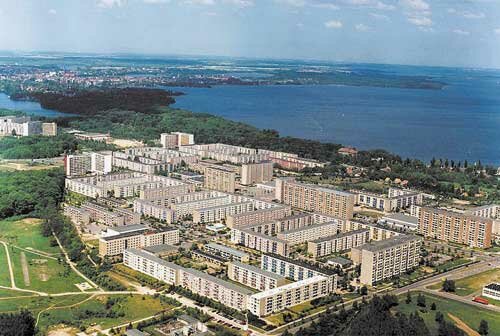 |
| The location of Neu Zippendorf in relation to downtown Schwerin (Source: Schwerin Municipality) |
These developments are a burden on community life in the model area. The various resident and age groups have differing life styles and notions about using the area. Migrants' language problems make communication with old-established residents, and thus integration, more difficult. The few integration facilities, recreational amenities, and places for contact are insufficient. Although a centre function had been planned for Neu Zippendorf, the corresponding facilities, especially in the cultural and educational fields, are lacking.
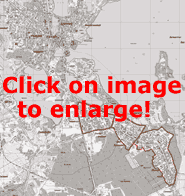 |
The new housing area Neu Zippendorf between woods and Lake Schwerin (Source: Schwerin Municipality) |
Constructional and economic problems are particularly apparent around Berliner Platz. This square had originally been planned as the centre for all three building phases. The construction of district centres in the two neighbouring estates in the mid-1990s largely deprived Berliner Platz of its centre function. The shops and weekly market partly downgraded their range, the quality and diversity of catering establishments declined, shop vacancies increased. What is more, the design of the square was aesthetically and functionally unsatisfactory.
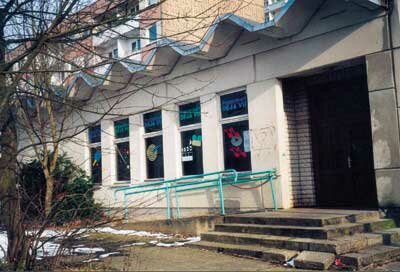 |
The outdoor areas of the youth club Deja Vu need to be rehabilitated and redesigned (Source: Cathy Cramer, Berlin) |
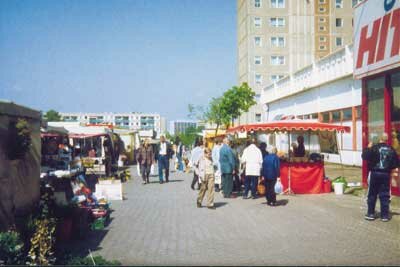 |
The weekly market in Berliner Platz attracts a large public (Source: Schwerin Municipality) |
The fact that modernisation and rehabilitation are not as advanced in Neu Zippendorf as in the other two districts has also had an unfavourable impact.
Many residents and business people regard the image of the district as damaged by the increase in socially disadvantaged population groups, clearly visible even in the outward appearance of the area, by changes in the retail and catering trades, and by vacant housing and infrastructural facilities.
The development potential of Neu Zippendorf includes its location between woods and lake, the good transport links with the inner city, land resources from building demolition and conversion, adequate shopping amenities, and the existing social and recreational infrastructure. The district offers two old-age and nursing homes, making it an important centre for residential old-age facilities. Other public services for the elderly, like the senior citizens' club, have a positive impact on social contacts between older residents. In early 2001, a neighbourhood centre was set up by the association "Hand in Hand" in collaboration with the housing cooperative Schweriner Wohnungsbaugenossenschaft, which is managed by a residents' advisory board.
Many residents have lived in the model area for a long time, and identify with the district; they maintain neighbourhoods and are already strongly involved in framework planning. Among the newly arrived migrant groups, family structures are often intact and they can help in the social stabilisation of the area. Their arrival has lowered the vacancy rate.
Demography and Social Space
|
Neu Zippendorf |
Schwerin |
|
|
Size |
70 ha |
13 033 ha |
|
Population (2000) |
8 019 |
103 084 |
|
Population decline (1993–2000) |
40 % |
20 % |
|
Average household size (2000) |
2.0 pers. |
2.2 pers. |
|
Number of dwellings (2001) |
4 497 |
59 046 |
|
Vacancy rate (2001) |
14 % |
13.7 % |
|
Housing benefit recipients (1999) |
n.a. |
11 % |
|
Unemployment rate (2000) |
23.6 % |
16.3 % |
|
Social assistance recipients (1999) |
4.5 % |
2.7 % |
|
Foreign population (2000) |
8.9 % |
3.3 % |
|
Population under 20 (2000) |
20.5 % |
19.8 % |
|
Population 60 and older (2000) |
24.9 % |
23.4 % |
In a survey of Berliner Platz business people, over 70% of respondents stated that, despite poor turnover, they had strong locational ties - a good basis for the planned development of a local economy concept with the business community.
3. Development Goals and Focal Points of Action 
In connection with the inclusion of Neu Zippendorf in the "Further Development of New Housing Areas - Residential Environment Improvement Programme," a framework plan (urban development and socio-communicative section) was drawn up between 1998 and 2000 in collaboration with residents, and a model was developed for the district under the title: "Neu Zippendorf: Attractive Living between Woods and Water."
On the basis of an analysis of the area's problems and potential, the framework plan stated the following objectives:
- to enhance the image of the district
- to increase the standing of Neu Zippendorf among the three new housing areas and the city as a whole;
- to strengthen economic and employment structures;
- to promote vocational qualifications in the area;
- to develop land resources;
- to stabilise neighbourhoods;
- to improve recreational and cultural amenities for all age and resident groups;
- to improve security and cleanliness in the district; to adapt dwelling environs for the disabled.
Working groups that have emerged from the district conference and the steering group have developed other goals at the district level, which have been confirmed by the district conference:
- to integrate foreigners and ethnic German immigrants;
- to improve facilities and services for children in the age groups 6-10 and 10-14;
- to improve public relations.
The most important areas of action to date have been:
- the establishment of a district centre at Berliner Platz, accompanied by redesign;
- the rehabilitation of the Astrid Lindgren School and its extension to provide a communication and event venue for the whole Dreesch area;
- additional recreational amenities for children and young people;
- the provision of opportunities for intercultural contacts and encounters;
- the redevelopment and demolition of residential buildings and infrastructural facilities;
- the conversion of vacant sites and infrastructural facilities;
- the coordination and interlinkage of the activities of civic action groups and private organisations in the area.
There is no integrated plan of action yet, but one is to be developed as the process unfolds. For application purposes, the Mecklenburg-West Pomerania government has accepted the framework plan as a first component.
Since the beginning of the "Socially Integrative City" programme, the focus of action and of projects has shifted away from dwelling rehabilitation and modernisation towards strengthening social activities and towards measures for promoting community cohesion.
4. Key Projects 
Since implementation of the "Socially Integrative City" programme began, greater emphasis has been placed on social-infrastructure and community-enhancement projects. The following are regarded as key projects for the further development and stabilisation of the model area.
Under the Voluntary Social Training Year project, disadvantaged young people are given the opportunity to gain occupational and social competence. This three-year qualification measure in organised by the Internationaler Bund (IB); the young people are under the care of by four social educationalists. The project is an element in the national programme platform "Development and opportunities for young people in deprived areas" (E & C) of the Federal Ministry for Family, Senior Citizens, Women, and Youth. To carry out this measure, former commercial premises were converted, providing an office and a café where the young people can meet.
The first bigger measure in 2000 was the establishment of the Talliner Strasse Neighbourhood Centre in collaboration with the Schweriner Wohnungsbausgenossenschaft (SWG) and "Hand in Hand." It provides a close-by, non-commercial leisure amenity, which offers a great deal for all age groups in the district. A residents' advisory board is responsible for the programme. The centre is organised by an area manager from the team that operates in the SWG neighbourhood centres, and a person from the neighbourhood agency Neu Zippendorf/Mueßer Holz. Their duties cover direct tenant advice, the promotion of neighbourly relations, and the provision of community services. The area manager is intended to be a contact person for rental issues, but also to provide advice as a person of confidence when residents have social and financial problems. With this concept, the neighbourhood centre contributes to strengthening and promoting community life and cohesion. It was opened in late January 2001.
The Astrid Lindgren School is to be rehabilitated and extended to include a cultural event centre. Owing to its central location for all three districts, the school is well suited to become the socio-cultural centre of the entire Dreesch area. In addition to rehabilitation, the concept covers three main elements:
- relocation of the district library from Großer Dreesch to Neu Zippendorf, thus improving accessibility for residents of the entire new housing area. The school will be provided with an extension for this purpose.
- roofing the school courtyard to create a multifunctional space for events;
- multiple use of classrooms, e.g. by the adult education centre and the conservatoire.
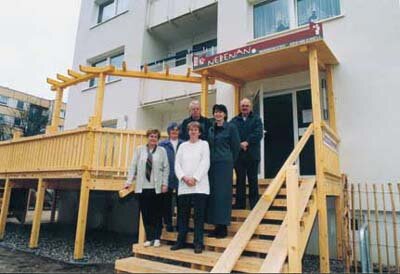 |
Staff of the neighbourhood centre (Source: Schwerin Municipality) |
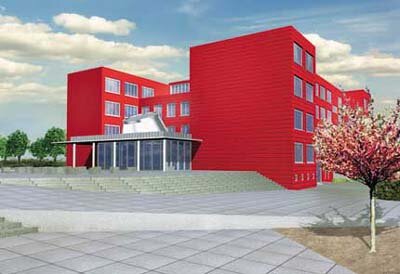 |
Astrid Lindgren School with planned extension and new facade (Source: Schwerin Municipality) |
Because of the importance of the measure, a policy decision on the project was adopted in the committees and the city council. Building was to begin in autumn 2001, and work is expected to be completed in the spring of 2003.
The redesign of Berliner Platz includes modernisation of the tramstop, rehabilitation and re-erection of the fountain, and improvements to the aesthetic and functional design. The first two measures were carried out in 2001. A residents' working group was set up for the redesign of the square, which made an active contribution to planning, for example with ideas on disablement friendly redesign, improved lighting and cleanliness.
5. Organisation and Management 
Framework plan organisational and management forms
Already in the course of framework planning special organisational structures at the administrative, intermediary, and implementation levels were established in the district. At the administrative level a steering group was set up under the chairmanship of the head of the building department, bringing together the head and staff of the city planning authority and representatives of other authorities, as well as the managing directors of the two housing companies, to discuss overriding issues. The working group "Building Neu Zippendorf" headed by the city planning authority - also with representatives from the directly involved administrative units - coordinated the framework planning between the various functional units and the housing companies.
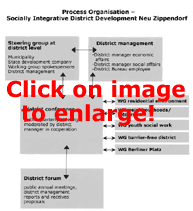 |
Process Organisation - Socially Integrative District Development Neu Zippendorf |
Since the start of renewal work, a member of staff from the city planning authority has been in control of continued development in the entire Dreesch area. He is assisted by a colleague from the development company Landesentwicklungsgesellschaft Schleswig-Holstein, which since 1997 has been supporting renewal work and managing funding on behalf of the municipality.
Four district forums have been staged on the planning and implementation steps in framework planning as developed in temporary resident working groups.
New organisational and management forms for implementing the "Socially Integrative City" programme"
To fit in better with the integrative approach of the new support programme, the organisational structure for implementation of the "Socially Integrative City" was expanded.
The most important change has been expansion of the steering group at the administrative level mentioned above to include additional relevant units. The administrative steering group is intended to ensure inter-authority cooperation and the interlinkage of resources (finance and know-how) between administration, housing companies, state development company, and the district management. The member of the city planning authority responsible for renewal throughout Dreesch is also in charge of implementing the "Socially Integrative City" programme in the model area.
In the intermediary area, a district conference has been set up in addition to the district forums. The conference is to meet quarterly. It is organised by the head of Regional Office 3 (Office for Youth, Social Affairs and Housing), which is also responsible for Neu Zippendorf, in cooperation with the district management "social affairs." The job of the district conference is to help prepare the basis for decisions on measures in the area. Working groups have emerged from the conference, which meet regularly. Their findings are publicly debated by the conference, recommendations are formulated and communicated to the political level, to local authorities, organisations and citizens' groups. It is therefore important to gain the support of politicians for the work of the district conference.
The district forum will be retained in future as an organisational form, and is to meet once a year to inform interested residents who cannot or do not wish to become regularly involved in the context of the district conference about the development of the district.
At the local implementation level, the "district management working party" was initiated at the beginning of the "Socially Integrative City" programme. It aims to integrate key people from public authorities and local institutions who already had performed central functions in the area during framework planning. Membership of the working party included the head of Regional Office 3, the district coordinator for child welfare, the E & C project manager from the Internationaler Bund, a staff member from the District Bureau, the competent member of staff from the city planning authority, and the on-the-spot programme support. The working group had the task of establishing adequate structures for implementing the "Socially Integrative City" programme, stimulating and promoting community-oriented work, and to describe problems for communication to the various bodies.
In late 2001, the "district management working group" merged with the "Neu Zippendorf steering group" (steering group at the district level), which also decides on the allocation of resources from the contingent fund. It includes members of the former "district management working party," the newly appointed district managers for "economic affairs" and "social affairs," and the heads of the working groups set up in the context of the district conference. Meetings take place monthly and are organised and documented by the staff of the District Bureau.
Since December 2001, area development has been supported by a newly appointed district manager for "economic affairs" and since March 2002 by two additional district managers for "social affairs." Besides working in the steering group at the district level, it is their task to promote and support projects in the fields of "local economy," "social activities," "infrastructure," "integration," "participation and activation," and "public relations." They hold surgeries for residents at the District Bureau.
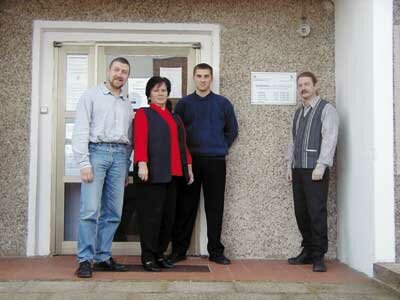 |
The District Bureau on Berliner Platz (Source: Schwerin Municipality) |
The District Bureau in Neu Zippendorf was set up in 1999. It is located centrally on Berliner Platz, and consists of an office for the staff and an anteroom where plan are exhibited and information on district development is laid out for interested residents and business people. Three members of staff are available as contact persons, two also being present in the two other district bureaus in Großer Dreesch and Mueßer Holz. At regular consulting hours, the District Bureau also offers an debt counselling service. Another room is available for discussions of group meetings. This is also where the steering group at district level meets.
6. Activation, Participation, and Public Relations 
The activation and involvement of residents and other district actors and area-specific public relations work for Neu Zippendorf are the responsibility of the district management, which is supported by the staff of the District Bureau.
Crucial for the activation of residents is the contingent fund granted by the Mecklenburg-West Pomeranian government in mid-2001, amounting to Euro 10,000 annually. It is to enable "responsible, self-determined local action in realising shorter-term smaller projects. The money can be used for the flexible promotion of neighbourhood activities, for events to animate district life, to support people in financial need with the aim of participation in social life, for occupational qualification in the context of voluntary activities, for the production of information material, etc. The money is allocated by the steering group at district level, and the district conference is regularly informed. Prerequisite for support is an at least 10% own contribution, which can also be in kind or the form of own work. Support may not exceed Euro 1,250 per application.
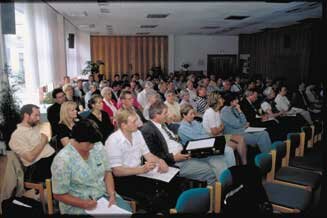 |
The starter conference at the launching of the "Socially Integrative City" programme attracted a great deal of interest (Source: Wolf-Christian Strauss, Berlin) |
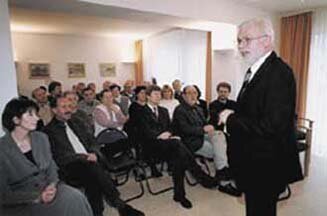 |
Opening of the neighbourhood centre "Next Door" (on the right: mayor Johannes Kwaschik) (Source: Schwerin Municipality) |
Already in the preparatory phase and framework planning itself, elements of dialogistic and activating citizen participation were provided for and implemented. At the neighbourhood level, they include the District Bureau, the resident working groups, and the public district forums. These forms of participation were developed in the context of implementing the "Socially Integrative City" programme, and supplemented at the intermediary level by the district conference and new, issue-specific working groups. In contrast to the district forum, which is an information body, the district conference discusses measures proposed by the working groups in a larger circle of residents and formulates recommendations. So far there have been working groups on the following subjects: "stabilisation of neighbourhoods, integration of immigrants," "improving the district centre Berliner Platz," "youth work/youth social work, improving recreational and cultural amenities," "improving the residential environment, increasing cleanliness and security." These working groups enable residents to participate directly.
Public forums are also held on particular topics, to which a broad public is invited and which is publicised in the media. In 2001 there was a housing forum and a workshop on "social and spatial problems in large-scale housing estates." The population has the opportunity to discuss local problems with the administrative authorities and propose solutions. Other forms of participation for various target groups are planned in the framework of intensified public relations.
In public relations work for the area, the District Bureau has a key role to play through the district management. This is where plans and models are exhibited, and where the interested public can obtain up-to-date information of the status of planning, on dates, and on projects that have been carried out. The District Bureau has designed a district logo for its work. Also planned are a district newspaper and a brochure on facilities for young and old in the district - also to be published in the Internet.
7. Conclusion: Set in Motion 
Since the start of implementation of the "Socially Integrative City" programme, the focus of action and projects in the development of Neu Zippendorf has shifted away from mainly constructional measures towards social and community-oriented projects that promote community cohesion between population groups. The combined use of resources from the "Socially Integrative City" programme and from other sources has contributed, as well as the establishment of a contingent fund. However no integrated plan of action for the area that includes citywide development has yet been drawn up.
The areas of action "employment," "qualification," and "training," as well as "economic development" have already been analysed in the framework plan, and the strengthening of economic and employment structures in the area has been identified as a goal; but a local economy concept is still to be developed by the district manager for "economic affairs" in collaboration with many local actors. It has proved an arduous task to gain the cooperation of local business people, potential start-up entrepreneurs, the chambers of industry and commerce, the chamber of crafts, and the employment office.
District development in Neu Zippendorf has been assisted by the establishment of the district conference and its working groups, even though politicians have not yet become involved. The inter-authority participation of the municipality in the district conference is not on a formal basis, but various administrative units are integrated in the conference via their issue-specific participation in the working groups.
At an early date, the District Bureau offered residents an important local contact point. By integrating private organisations and the regional office in the steering group at district level, a permanent cooperation body has been established. The three district manager, under temporary contract, give additional support to the district development process through stepped-up district public relations work, resident activation and participation, and project development in the fields "local economy" and "social activities/living together in the district."
Resident participation has been achieved above all in the planning and implementation of concrete projects. Non-German-speaking population groups have so far not been reached or only tentatively. This is an important field of activity for the two district managers for "social affairs": to increase the participation of the population and boost their engagement. At the same time, they must coordinate and interlink the many activities of private organisations in the area. Community work must be given greater priority.
Public relations must be intensified, because many residents are not or only partly aware of changes that occur in the area. Increased area-specific public relations is necessary if only to inform a broader public about planning and implementation progress, and thus to improve the image of the area. This is a job for the district managers; together with residents they will develop an PR concept to take residents' information needs into account and motivate them to cooperate.
The new federal programme "Urban Redevelopment" gives the model area the opportunity to reduce vacancy rates through partial and complete demolition of housing elements. By July 2002, a citywide urban redevelopment programme is to be drawn up by the municipality in collaboration with the housing companies, in which the development of Neu Zippendorf will play an important role.
From 2002, the programme area Neu Zippendorf has been extended to include the district Mueßer Holz, and the district managers for "social affairs" are now responsible for both districts. The coordination and networking of activities in the two districts will certainly benefit.
Im Auftrag des BMVBS vertreten durch das BBR. Zuletzt geändert am 25.05.2005